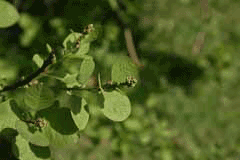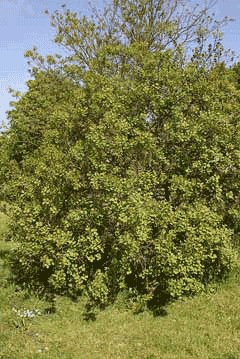 |
|
http://commons.wikimedia.org/wiki/User:Sten |
 |
| http://commons.wikimedia.org/wiki/User:Sten |
Translate this page:
Summary
Bloom Color: Pink, White.
Main Bloom Time: Early spring, Late spring, Mid spring. Form: Rounded.
Physical Characteristics

 Cotinus obovatus is a deciduous Shrub growing to 10 m (32ft) by 8 m (26ft) at a medium rate.
Cotinus obovatus is a deciduous Shrub growing to 10 m (32ft) by 8 m (26ft) at a medium rate.
See above for USDA hardiness. It is hardy to UK zone 5. It is in flower from April to May, and the seeds ripen in September. The species is dioecious (individual flowers are either male or female, but only one sex is to be found on any one plant so both male and female plants must be grown if seed is required). . The plant is not self-fertile.
Suitable for: light (sandy), medium (loamy) and heavy (clay) soils, prefers well-drained soil and can grow in nutritionally poor soil. Suitable pH: mildly acid, neutral and basic (mildly alkaline) soils. It can grow in semi-shade (light woodland) or no shade. It prefers moist soil.
UK Hardiness Map
US Hardiness Map
Synonyms
C. americanus. Rhus cotinoides.
Plant Habitats
Woodland Garden Dappled Shade; Shady Edge;
Edible Uses
References More on Edible Uses
Medicinal Uses
Plants For A Future can not take any responsibility for any adverse effects from the use of plants. Always seek advice from a professional before using a plant medicinally.
None known
References More on Medicinal Uses
The Bookshop: Edible Plant Books
Our Latest books on Perennial Plants For Food Forests and Permaculture Gardens in paperback or digital formats.

Edible Tropical Plants
Food Forest Plants for Hotter Conditions: 250+ Plants For Tropical Food Forests & Permaculture Gardens.
More

Edible Temperate Plants
Plants for Your Food Forest: 500 Plants for Temperate Food Forests & Permaculture Gardens.
More

More Books
PFAF have eight books available in paperback and digital formats. Browse the shop for more information.
Shop Now
Other Uses
Dye Wood
An orange or yellow dye is obtained from the wood[46, 61, 82, 169]. This was extensvely used in America at the time of the Civil War, but is little used commercially at present[274]. Wood - light, soft, rather coarse grained, very durable in the soil[82, 149, 229]. It weighs about 40lb per cubic foot[235]. Trees are too small and rare for commercial exploitation, but the wood is used locally for fence posts[82, 149, 229].
Special Uses
Scented Plants
References More on Other Uses
Cultivation details
Landscape Uses:Standard, Specimen. Tolerates most soils[202]. Prefers a well-drained soil in a sunny position[200], doing better in a soil that is not very rich[11]. Tolerates light shade[188]. Plants are hardy to about -15°c[202], though die-back often occurs at the tips of shoots during the winter[202]. Plants are slow to establish but are then quite fast growing when young though they slow down with age[202]. Plants respond well to coppicing[229]. Hybridizes with C. coggygria[182]. A very ornamental plant[1]. The young leaves have an aromatic fragrance when bruised[245]. This species is in danger of extinction in the wild due to its being cut down for use in making a dye, this occurred especially during the N. American civil war[Notes on a board at Kew]. Plants flower on wood that is at least 3 years old[202]. Any pruning is best done in the spring[202]. Seed production is normally poor because many of the flower clusters are sterile[229]. Dioecious. Male and female plants must be grown if seed is required. Special Features:North American native, Attractive flowers or blooms.
References Carbon Farming Information and Carbon Sequestration Information
Temperature Converter
Type a value in the Celsius field to convert the value to Fahrenheit:
Fahrenheit:
The PFAF Bookshop
Plants For A Future have a number of books available in paperback and digital form. Book titles include Edible Plants, Edible Perennials, Edible Trees,Edible Shrubs, Woodland Gardening, and Temperate Food Forest Plants. Our new book is Food Forest Plants For Hotter Conditions (Tropical and Sub-Tropical).
Shop Now
Plant Propagation
Seed - best sown as soon as it is ripe in a cold frame[78, 113, 200]. It should germinate in the spring. Slightly immature or 'green' seed, harvested when it has fully developed but before it dries on the plant, gives the best results[113]. Warm stratify stored seed for 2 - 3 months at 15°c, then cold stratify for 2 - 3 months[164]. Germination can be very slow, often taking 12 months or more at 15°c[164]. When they are large enough to handle, prick the seedlings out into individual pots and grow them on in the cold frame for at least their first winter. Plant them out into their permanent positions in late spring or early summer, after the last expected frosts. The seed has a long viability and should store for several years[113]. Cuttings of half-ripe wood, July/August in a frame[113]. Trench layering in spring[200].
Other Names
If available other names are mentioned here
Native Range
NORTHERN AMERICA: United States (Missouri (southwest), Oklahoma, Alabama (northeast), Arkansas (north), Tennessee, Texas (s.-c.))
Weed Potential
Right plant wrong place. We are currently updating this section.
Please note that a plant may be invasive in one area but may not in your area so it's worth checking.
Conservation Status
IUCN Red List of Threatened Plants Status :

Growth: S = slow M = medium F = fast. Soil: L = light (sandy) M = medium H = heavy (clay). pH: A = acid N = neutral B = basic (alkaline). Shade: F = full shade S = semi-shade N = no shade. Moisture: D = dry M = Moist We = wet Wa = water.
Now available:
Food Forest Plants for Mediterranean Conditions
350+ Perennial Plants For Mediterranean and Drier Food Forests and Permaculture Gardens.
[Paperback and eBook]
This is the third in Plants For A Future's series of plant guides for food forests tailored to
specific climate zones. Following volumes on temperate and tropical ecosystems, this book focuses
on species suited to Mediterranean conditions—regions with hot, dry summers and cool, wet winters,
often facing the added challenge of climate change.
Read More
Expert comment
Author
Raf.
Botanical References
1143200
Links / References
For a list of references used on this page please go here
Readers comment
© 2010, Plants For A Future. Plants For A Future is a charitable company limited by guarantee, registered in England and Wales. Charity No. 1057719, Company No. 3204567.